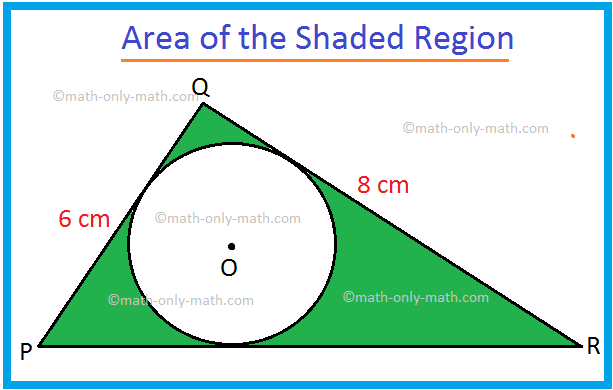Subscribe to our ▶️ YouTube channel 🔴 for the latest videos, updates, and tips.
Area of the Shaded Region
We will learn how to find the Area of the shaded region of combined figures.
To find the area of the shaded region of a combined geometrical shape, subtract the area of the smaller geometrical shape from the area of the larger geometrical shape.
Solved Examples on Area of the Shaded Region:
1. In the adjoining figure, PQR is a right-angled triangle in which ∠PQR = 90°, PQ = 6 cm and QR = 8 cm. O is the centre of the incircle.
Find the area of the shaded regions. (Use π = \(\frac{22}{7}\))
Solution:
The given combined shape is combination of a triangle and incircle.
To find the area of the shaded region of the given combined geometrical shape, subtract the area of the incircle (smaller geometrical shape) from the area of the ∆PQR (larger geometrical shape).
Required area = area of the ∆PQR – Area of the incircle.
Now, area of the ∆PQR = \(\frac{1}{2}\) × 6 cm × 8 cm = 24 cm2.
Let the radius of the incircle be r cm.
Clearly, QR = \(\sqrt{PQ^{2} + QR^{2}}\)
= \(\sqrt{6^{2} + 8^{2}}\) cm
= \(\sqrt{36 + 64}\) cm
= \(\sqrt{100}\) cm
= 10 cm
Therefore,
Area of ∆OPR = \(\frac{1}{2}\) × r × PR
= \(\frac{1}{2}\) × r × 10 cm2.
Area of ∆ORQ = \(\frac{1}{2}\) × r × QR
= \(\frac{1}{2}\) × r × 8 cm2.
Area of ∆OPQ = \(\frac{1}{2}\) × r × PQ
= \(\frac{1}{2}\) × r × 6 cm2.
Adding these, area of the ∆PQR = \(\frac{1}{2}\) × r × (10 + 8 + 6) cm2.
= 12r cm2.
Therefore, 24 cm2 = 12r cm2.
⟹ r = \(\frac{24}{12}\)
⟹ r = 2
Therefore, the radius of the incircle = 2 cm.
So, the area of the incircle = πr2
= \(\frac{22}{7}\) × 22 cm2.
= \(\frac{22}{7}\) × 4 cm2.
= \(\frac{88}{7}\) cm2.
Therefore, the required area = Area of the ∆PQR – Area of the incircle.
= 24 cm2 - \(\frac{88}{7}\) cm2.
= \(\frac{80}{7}\) cm2.
= 11\(\frac{3}{7}\) cm2.
2. In the adjoining figure, PQR is an equailateral triangle of side 14 cm. T is the centre of the circumcircle.
Find the area of the shaded regions. (Use π = \(\frac{22}{7}\))
Solution:
The given combined shape is combination of a circle and an equilateral triangle.
To find the area of the shaded region of the given combined geometrical shape, subtract the area of the equilateral triangle PQR (smaller geometrical shape) from the area of the circle (larger geometrical shape).
The required area = Area of the circle – The area of the equilateral triangle PQR.
Let PS ⊥ QR.
In the equilateral triangle SR = \(\frac{1}{2}\) QR
= \(\frac{1}{2}\) × 14 cm
= 7 cm
Therefore, PS = \(\sqrt{14^{2} – 7^{2}}\) cm
= \(\sqrt{147}\) cm
Also, in an equilateral triangle, the circumcentre T coincides with the centroid.
So, PT = \(\frac{2}{3}\)PS
= \(\frac{2}{3}\)\(\sqrt{147}\) cm
Therefore, the circumradius = PT = \(\frac{2}{3}\)\(\sqrt{147}\) cm
Therefore, area of the circle = πr2
= \(\frac{22}{7}\) × \((\frac{2}{3}\sqrt{147})^{2}\) cm2.
= \(\frac{22}{7}\) × \(\frac{4}{9}\) × 147 cm2.
= \(\frac{616}{3}\) cm2.
And area of the equilateral triangle PQR = \(\frac{√3}{4}\) PR2
= \(\frac{√3}{4}\) × 142 cm2.
= \(\frac{√3}{4}\) × 196 cm2.
= 49√3 cm2.
Therefore, the required area = Area of the circle – The area of the equilateral triangle PQR.
= \(\frac{616}{3}\) cm2 - 49√3 cm2.
= 205.33 – 49 × 1.723 cm2.
= 205.33 – 84.868 cm2.
= 120.462 cm2.
= 120.46 cm2. (Approx).
From Area of the Shaded Region to HOME PAGE
Didn't find what you were looking for? Or want to know more information about Math Only Math. Use this Google Search to find what you need.



New! Comments
Have your say about what you just read! Leave me a comment in the box below. Ask a Question or Answer a Question.